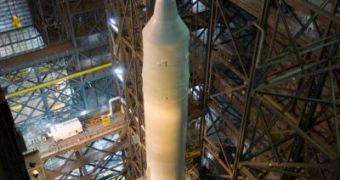In spite of announcing earlier that the new ARES I-X prototype rocket would be rolled to its launch pad a few days earlier than first planned, NASA steps out again to inform people that the rollout will be delayed by at least a day. The reschedule is due to a fault in the prototype's steering system, and, apparently, engineers are currently working around the clock on fixing it. The craft is scheduled to take off on October 27 from the Kennedy Space Center's (KSC) Launch Pad 39B, which has been especially modified to support vehicles from Project Constellation, Space reports.
The 327-foot (100-meter) -tall rocket is the suborbital version of NASA's ARES I delivery system, which is envisioned to carry the Orion Crew Exploration vehicle to low-Earth orbit. They form the first new class of rockets that NASA has designed in more than two decades, and everyone is waiting the first test flight with anticipation. A success in the planned launch, and Project Constellation may finally get some much-needed validation, for the $9 billion it has spent over the past five years. The NASA review committee that recently concluded its investigation proposes that the Project be replaced and the space agency really needs to demonstrate otherwise.
Engineers working on ARES I-X had a full two weeks ahead of their planned schedule, and repeatedly said that they would use the extra time to troubleshoot any potential flaws that might appear with the rocket. However, in the end, four of the 14 days were not needed, so the launch itself was moved ahead. This is a very rare occurrence, as lift-off sequences are usually pushed back and delayed, and not the other way around. ARES I-X was originally scheduled for launch in July, but the deadline could not be respected. The same thing happened with an August launch date.
“The rollout was originally planned for October 19, but the new delay will likely push that date back by at least a day. It's at least a day, but it's still kind of a developing story. We'll have to see how things go for us,” NASA spokesperson George Diller said. The faulty piece of machinery “is associated with the steering and stabilization of the rocket during flight,” he revealed. The take-off window for the ARES I-X rocket is extremely narrow, as the space agency can only launch it on October 27-28. Any later, and it will not benefit from the absolutely vital assistance of the Eastern range tracking facility.

 14 DAY TRIAL //
14 DAY TRIAL //